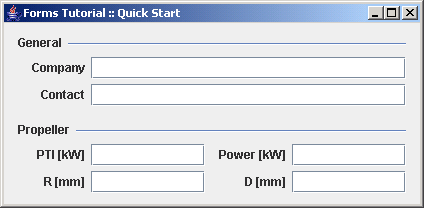Create and configure a layout, create a builder, add components

/*
* Copyright (c) 2002-2004 JGoodies Karsten Lentzsch. All Rights Reserved.
*
* Redistribution and use in source and binary forms, with or without
* modification, are permitted provided that the following conditions are met:
*
* o Redistributions of source code must retain the above copyright notice,
* this list of conditions and the following disclaimer.
*
* o Redistributions in binary form must reproduce the above copyright notice,
* this list of conditions and the following disclaimer in the documentation
* and/or other materials provided with the distribution.
*
* o Neither the name of JGoodies Karsten Lentzsch nor the names of
* its contributors may be used to endorse or promote products derived
* from this software without specific prior written permission.
*
* THIS SOFTWARE IS PROVIDED BY THE COPYRIGHT HOLDERS AND CONTRIBUTORS "AS IS"
* AND ANY EXPRESS OR IMPLIED WARRANTIES, INCLUDING, BUT NOT LIMITED TO,
* THE IMPLIED WARRANTIES OF MERCHANTABILITY AND FITNESS FOR A PARTICULAR
* PURPOSE ARE DISCLAIMED. IN NO EVENT SHALL THE COPYRIGHT OWNER OR
* CONTRIBUTORS BE LIABLE FOR ANY DIRECT, INDIRECT, INCIDENTAL, SPECIAL,
* EXEMPLARY, OR CONSEQUENTIAL DAMAGES (INCLUDING, BUT NOT LIMITED TO,
* PROCUREMENT OF SUBSTITUTE GOODS OR SERVICES; LOSS OF USE, DATA, OR PROFITS;
* OR BUSINESS INTERRUPTION) HOWEVER CAUSED AND ON ANY THEORY OF LIABILITY,
* WHETHER IN CONTRACT, STRICT LIABILITY, OR TORT (INCLUDING NEGLIGENCE
* OR OTHERWISE) ARISING IN ANY WAY OUT OF THE USE OF THIS SOFTWARE,
* EVEN IF ADVISED OF THE POSSIBILITY OF SUCH DAMAGE.
*/
import javax.swing.JComponent;
import javax.swing.JFrame;
import javax.swing.JTextField;
import javax.swing.UIManager;
import javax.swing.WindowConstants;
import com.jgoodies.forms.builder.PanelBuilder;
import com.jgoodies.forms.layout.CellConstraints;
import com.jgoodies.forms.layout.FormLayout;
/**
* Quickly introduces the most important features of the FormLayout:
* create and configure a layout, create a builder, add components.<p>
*
* Note that this class is not a JPanel subclass;
* it justs uses a JPanel as layout container that will be returned
* by <code>#buildPanel()</code>.
*
* @author Karsten Lentzsch
* @version $Revision: 1.8 $
*/
public class QuickStartExample {
private JTextField companyField;
private JTextField contactField;
private JTextField ptiField;
private JTextField powerField;
private JTextField radiusField;
private JTextField diameterField;
public static void main(String[] args) {
try {
UIManager.setLookAndFeel("com.jgoodies.plaf.plastic.PlasticXPLookAndFeel");
} catch (Exception e) {
// Likely PlasticXP is not in the class path; ignore.
}
JFrame frame = new JFrame();
frame.setTitle("Forms Tutorial :: Quick Start");
frame.setDefaultCloseOperation(WindowConstants.EXIT_ON_CLOSE);
JComponent panel = new QuickStartExample().buildPanel();
frame.getContentPane().add(panel);
frame.pack();
frame.setVisible(true);
}
// Component Creation and Initialization **********************************
/**
* Creates, intializes and configures the UI components.
* Real applications may further bind the components to underlying models.
*/
private void initComponents() {
companyField = new JTextField();
contactField = new JTextField();
ptiField = new JTextField(6);
powerField = new JTextField(10);
radiusField = new JTextField(8);
diameterField = new JTextField(8);
}
// Building *************************************************************
/**
* Builds the panel. Initializes and configures components first,
* then creates a FormLayout, configures the layout, creates a builder,
* sets a border, and finally adds the components.
*
* @return the built panel
*/
public JComponent buildPanel() {
// Separating the component initialization and configuration
// from the layout code makes both parts easier to read.
initComponents();
// Create a FormLayout instance on the given column and row specs.
// For almost all forms you specify the columns; sometimes rows are
// created dynamically. In this case the labels are right aligned.
FormLayout layout = new FormLayout(
"right:pref, 3dlu, pref, 7dlu, right:pref, 3dlu, pref", // cols
"p, 3dlu, p, 3dlu, p, 9dlu, p, 3dlu, p, 3dlu, p"); // rows
// Specify that columns 1 & 5 as well as 3 & 7 have equal widths.
layout.setColumnGroups(new int[][]{{1, 5}, {3, 7}});
// Create a builder that assists in adding components to the container.
// Wrap the panel with a standardized border.
PanelBuilder builder = new PanelBuilder(layout);
builder.setDefaultDialogBorder();
// Obtain a reusable constraints object to place components in the grid.
CellConstraints cc = new CellConstraints();
// Fill the grid with components; the builder offers to create
// frequently used components, e.g. separators and labels.
// Add a titled separator to cell (1, 1) that spans 7 columns.
builder.addSeparator("General", cc.xyw(1, 1, 7));
builder.addLabel("Company", cc.xy (1, 3));
builder.add(companyField, cc.xyw(3, 3, 5));
builder.addLabel("Contact", cc.xy (1, 5));
builder.add(contactField, cc.xyw(3, 5, 5));
builder.addSeparator("Propeller", cc.xyw(1, 7, 7));
builder.addLabel("PTI [kW]", cc.xy (1, 9));
builder.add(ptiField, cc.xy (3, 9));
builder.addLabel("Power [kW]", cc.xy (5, 9));
builder.add(powerField, cc.xy (7, 9));
builder.addLabel("R [mm]", cc.xy (1, 11));
builder.add(radiusField, cc.xy (3, 11));
builder.addLabel("D [mm]", cc.xy (5, 11));
builder.add(diameterField, cc.xy (7, 11));
// The builder holds the layout container that we now return.
return builder.getPanel();
}
}
 forms.zip( 197 k)
forms.zip( 197 k)Related examples in the same category